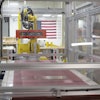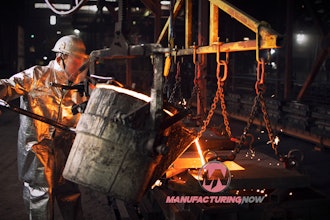IIoT Implementation Guide
4 steps to make your factory
smart quickly
2
Step 1
Identifying the internal champion who will lead the project
Time required for this step:
30 minutes to 1 week
Focus on dataListen
For your project to be successful within the company, it is essential to target an internal champion who will manage it from the
beginning to the end. This individual must be able to initiate, facilitate and implement the changes experienced by manufacturers. Think
of someone who could act as a leader, visionary and convener... The person who will take on this role must be able to guide the teams
around a single digital vision in order to provide a clear direction step by step to achieve the desired results.
In this context, being a good listener and being able to focus on data are the two essential qualities that your champion must possess,
since the champion’s mission will be to get feedback from the teams in order to achieve common goals. This person must have an in-
depth knowledge of the production processes, since he uses the machines on the line.
Because of his rigor and ability to manage change, this champion
would be an outstanding coach within his team. The champion
would therefore know the importance of making crucial
decisions at the right time based on the analyses collected in
order to improve the production processes. This leader must be
able to build relationships with influential people and must also
have strong problem-solving skills.
Do you already have someone in mind who’d be perfect for this
role? Since the implementation of a IIoT solution is an important
project, inform this person of your objectives and start your
technological shift off on the right foot!
Once your champion is identified, you are ready to take the
next step!
2
“As employees are aware of their impact on production, downtime has been reduced without other continuous
improvements. Employees showed due diligence by reducing set-up times and reacting more quickly when
problems occurred on the line. Over time, by making better and better use of the application, I will identify even
more opportunities for improvement and benefits related to the use of Tileboard.” - Jahziel Ugalde Angeles, VP
of Operations Lol Tun
3
Step 2
Identifying the bottleneck in the factory
Time required for this step:
30 minutes to 1 week
In each manufacturing company, identifying and managing bottlenecks is a major challenge. Since these bottlenecks can greatly affect
your production, it is important to identify them and to readjust to continuously improve.
Here are 5 tips to help you do this:
Identify your Machines with the Most Production in Progress
In a discreet production context (mode event) we should identify the machine that has the most parts or “jobs” waiting,
which tells us about the availability. In the case of continuous processes such as a production line, we identify the line or
lines that prevent us from producing more finished products every day (e. g. packaging).
Identify Some Machines that are Interdependent
Next, it is necessary to identify the machines that depend on each other, since a bottleneck can occur at different places
in your factory depending on the orders to be produced. When there is a slowdown, production is not optimal.
Determine the Equipment that is the Most Expensive to Use
It is relevant to determine which equipment is the most expensive in terms of use. Indeed, sometimes a machine requires
more employees, or the consumption, energy costs or acquisition costs are too high. Once you have connected your
factory, it will be even easier to follow this metric.
Consider Raw Material Costs
Considering the raw material costs produced by a machine allow us to monitor the potential waste of resources. In order
to prevent losing money, this bottleneck must be prevented.
Identify the Machines with the Fastest Throughput
The fast throughput of some machines can cause significant slowdowns if they are stopped or configured at speeds below
established standards. By identifying these machines, we are on the lookout for a potential bottleneck.
1
2
3
4
5
“The overall big picture of our production thanks to TileBoard has
allowed us to understand where our main downtimes are and what
could be beneficial for us. That’s why we want to invest more time,
energy and resources in this technology to use the tool to its full
potential.” - Dave Lamothe, Première Moisson
4
Step 3
Identifying what we want measured in the factory
Time required for this step:
30 minutes to 1 week - Learn more here
This step is crucial in determining what you want to measure in the factory to optimize production. Numerous indicators can be
measured: machine downtimes, machine production speed, cycle times, temperature, flow rate, the amount of energy, etc.
On the other hand, there are indicators common to all machines or production lines: unplanned downtimes. So why not start by
measuring unplanned downtime, a performance indicator that everyone in your company understands and values? The frequency and
duration with which they occur is therefore measured in order to prevent them. Real-time data collection (IIoT) and algorithms can
be used to implement concrete actions to improve the overall productivity. This data helps to compare teams and create a culture of
continuous improvement.
Two Types of Production
4 Key Performance Indicators (KPIs)
Continuous Production line
In this case, we want to know the percentage of
availability, the number of minutes of each downtime
and their frequency, as well as the production speed.
Batch Production on Machines
In this environment, we want to know the percentage
of the uptime. If it is a machine that produces few
parts, but each part requires a lot of time, then you
will want to measure the production cycle time for a
batch.
Downtime
Measuring downtimes on a machine in quantities (1,2,10) and in minutes.
There is the possibility of calculating each event or to accumulate them.
The calculation of downtime costs.
Speed Measuring the production speed.
Uptime Calculating production time without interruption.
Cycles Calculating the time it takes a machine to produce a batch from start to finish.
5
Step 4
Calculating the project’s ROI
Time required for this step:
30 minutes with our ROI calculator / 1 week if you do it yourself
Firstly, it is essential to analyze the potential benefits of large-scale
deployment of the IIoT in your factory. To do this, you must calculate the
ROI (return on investment) of the project. We have therefore created a
ROI calculator, allowing you to become aware of the added value of such a
project.
Once estimated, you will then be able to create an objective to see if your
ROI has been achieved or not, which will ensure that you can evaluate the
effectiveness of your large-scale deployment of your IIoT project in your
factory.
There are several factors to consider when developing your objectives:
You will see that the introduction of new technologies generates rapid returns on investment in the first few months. They do not require
significant investments or heavy infrastructure. The SaaS solutions enable you to take advantage of the technological innovations that
will enhance the platforms used, including augmented reality, geolocation, data science and artificial intelligence.
Calculate my ROI now
Number of continuous lines or number of machines
Average purchase cost of a line or machine
Part maintenance cost per year
Monthly energy expenditure
Number of employees per machine per line
Number of shifts per day
Average hourly wage
“We expected, of course, to reduce our costs.
We are surprised, however, by the extent of
what we have been able to save so far and
know that there is still more to look for! Our
goals seemed to be hard to achieve but they
were even surpassed.” - Charles Tremblay,
Ecoservice TRIA
6
The rise of the industry 4.0 and IIoT has led to the emergence of a host of innovative technologies. Most of them are cloud computing,
they do not require any infrastructure and most of them are offered in SaaS (Software as a service) model that allows you to take
advantage of technologies and services through monthly subscriptions rather than having to make a huge investment at the beginning
of the project. The ROI is therefore quickly appreciable and the risks are very low.
A Quick Installation
Did you know that the Worximity solution can be implemented and installed within one to five days? This technology allows you
to measure your KPI before and after optimization, to better see the impact of the projects that have been carried out. After all,
without actual data, only rough estimates can be made that carry some risk.
Simple to Use
The Existing ERP software requires long and sophisticated customization while custom systems require the installation of servers
and PLCs to be configured to meet manufacturers’ monitoring needs. However, with a IIoT solution, you can view your production
data in real time on your mobile devices or computers without having to make a specific and costly configuration. This gives you
more time to focus on continuous productivity improvement.
A Gradual Implementation
The IIoT can gradually take shape in your factory, machine by machine, according to your priorities. Start with key items, familiarize
your teams with the new mobile tools and then spread these new smart factory practices to all your facilities. It is better to start
right now and optimize your factory over time than to wait until everything is already perfect.
Why choose a SAAS
plug & play technology solution?
7
Quickly Adapt to the IIoT Wave
The move towards the IIoT is definitely an opportunity to seize as quickly as possible since it will allow you to increase your production.
On the other hand, it has been said that the first companies to make this shift will be approximately 3 times more successful (10% vs.
27%) in combining revenue gains and cost reductions than those that will remain passive by 20201.
Digital technology continues to become more and more important in a wide range of manufacturing sectors, to varying degrees. While
the consumer goods industry has a digital penetration rate of 31%, the automation and assembly industry has a 32% digital penetration
rate. These figures therefore confirm the strong interest in IIoT.
Choose a Turnkey Solution
The Worximity solution allows you to connect your production line in order to automatically extract data in real time. By connecting
all your equipment, you will be able to accurately track the movement of a bottleneck. So, you can quickly take action to bring your
production back to its highest point of optimization.
Having an overview will help you make better decisions every day. By connecting as much of your equipment as possible to intelligent
software, you will achieve a greater efficiency in your factory and increase your overall ROI. Ultimately, the IIoT helps industries to
become more digital, with the aim of improving processes through interconnectivity between machines and labor in real time, which
then leads to productivity gains.
1 According to PricewaterhouseCoopers: https://www.pwc.com/gx/en/industries/industries-4.0/landing-page/industry-4.0-building-your-digital-enterprise-april-2016.pdf
“Data is the key. The easier it is to access crucial information,
the more efficient we tend to be” - Billy Dedes, President
Central Bernard
8
To highlight the extent to which the IIoT will benefit companies that have seized this revolutionary wave, here are some interesting
figures:
Woodworking industry
20% improvement in productivity after 6 months
+11% of uptime after 6 months
-16% of direct labor cost after 6 months
Metal Industry
+17% of productivity after 4 months
-33% of the number of stoppages after 4 months
+15% of uptime after 4 months
-15% of the direct labor costs after 4 months
Consumer Goods Industry
+30% of productivity after 2 months
-25% of downtime after 2 months
Bottling Industry
-7% of direct labor costs
-49% of downtime after 2 months
Plastics Industry
+15% of uptime after 6 months
+34% of the Overall Equipment Effectiveness (OEE) after 6 months
35%
of companies that are moving
towards the industry 4.0 will
grow by 20% over the next
five years2.
43%
of companies making the
shift to the industry 4.0
expect to reduce their costs
by more than 20% over the
next five years.
56%
of the 4.0 companies plan to
increase their efficiency by
more than 20% over the next
five years.
Statistics of different industries after the adoption of the IIoT
2 https://www.forbes.com/sites/louiscolumbus/2016/08/07/industry-4-0-is-enabling-a-new-era-of-manufacturing-intelligence-and-analytics/#7fe7c8067ad9
4 steps to make your factory smart quickly
Latest in Home






















